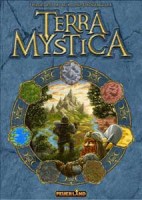
Terra Mystica
Overview
As one of fourteen different races, you seek to expand your control over the land itself. Transforming (or Terraforming) the landscape to your preferred habitat will allow you to build and expand your dwellings, granting you more workers to build, priests to increase your influence in certain cults, terraforming skills, travel capabilities and Power, which will grant you even more potent abilities to dominate the landscape and push the other competing races out.
Players begin with a bonus card of their choosing, which may grant more Coins or Workers (key to building) and Spades (crucial for transforming unsavory land into your own habitable terrain). Buildings can be upgraded by multiple steps providing increased abilities and ultimately the ability to establish Towns, which grant immediate rewards. After six turns of taking actions based on available resources, and with a specific reward each round, players count their advancement on the Cult Track and the scoring area of their structures. The player with the most Victory points is declared the winner and ruler of Terra Mystica!
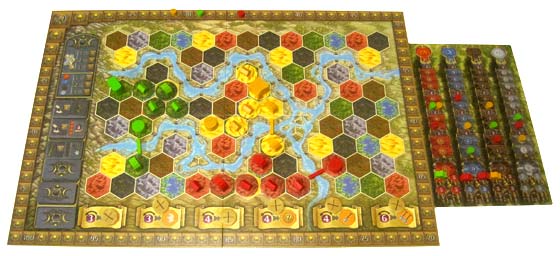
Set Up
The game board for Terra Mystica is divided into land masses of 7 different types separated by a river. Along the side of the main game board is placed the Cult board. Players choose one of the 14 factions and take all the game components associated with that faction. The Faction board displays all of your resources and game action abilities during the game. Onto the Faction board are placed the faction’s Structure tokens. Players also receive 7 Priest tokens and 3 bridge tokens. Lastly, there are 7 cylindrical markers in the faction color that are placed at various points to indicate your progress and abilities with certain game actions: the Shipping Track, the Exchange track, one on the “0” spaces for each cult track on the Cult board, and finally one on the “20” space on the Victory point track that outlines the main board. On the upper right of each Faction board are the starting resources for that Faction; this may indicate a number of Workers, Coins, Priests or any combination of these. Also the specific faction will begin with some influence in one or more of the Cults. The players’ tokens on the Cult track are moved up one space for each matching Cult symbol on their Faction board. Lastly on the upper left of the Faction board are the “Bowls of Power.” 12 purple tokens are placed here divided between Bowls I and II as indicated on the Faction board.
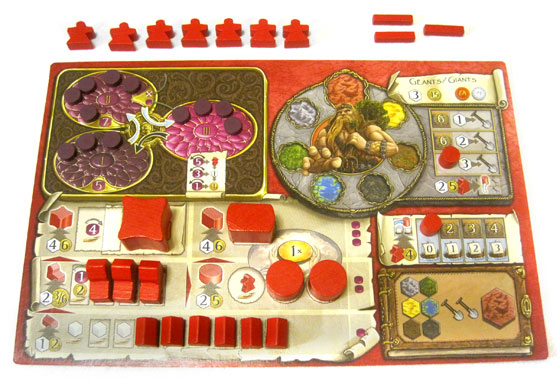
Once the Factions boards are set for each player, the main board is set up. This includes setting up the Favor Tiles, Bonus cards, Action tokens, Town tokens, extra workers and Coins. Most importantly, the Scoring tokens are shuffled and 6 are chosen and placed on each of the game turn track spaces. The Game End token is placed on the right side of Scoring token on the topmost space.
Now the players are ready to place their starting Dwellings on the board. A starting player is chosen randomly and that player chooses an existing home terrain space (matching their faction) and places on of their Dwellings on that space. This continues in clockwise order until the last player has placed a dwelling. Then beginning with that last player, and in counterclockwise order, a dwelling is placed on another existing home terrain space. Each player then begins with 2 Dwellings on the board. Beginning with the last player, and going counterclockwise, all players choose a Bonus tile from those available. Terra Mystica is about to begin!
Gameplay
Terra Mystica lasts six turns and each turn is broken down into three phases that all players must complete in player order before the next turn begins. The Phases are: Phase I: Income, Phase II: Actions, and Phase III: Cult Bonuses and Cleanup.
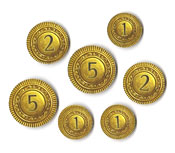
Phase I: Income
Simply put, each faction in player order gains new Workers, Coins, Priests or Power: the game’s four resources. There are many things that can generate income for a turn. Most come from the buildings you have built thus far in the game. Workers are gained depending on the number of Dwellings you have built. Coins and Power are generated depending on the number of Trading houses you have built. Priests are generated depending on the number of Temples and Sanctuaries you have built. And Power is also gained by building Strongholds. Bonus cards and Favor tiles can also generate income.
Once all Income is collected from all sources, the Actions Phase begins.
Phase II: Actions
Beginning with the starting player and going clockwise, all players take one action. This continues until all players pass. There are 8 possible actions a player can take:
-
Transform and Build
Dwellings can only be built on the home terrain for your faction. So this action allows you to terraform any unoccupied space into your home terrain. After which, you may build a dwelling on this space. To Terraform a space on the board, determine the cost on the Transformation Cycle on the Faction board. Each step between the source and destination space will cost one Spade. Spades are acquired by trading workers at a rate determined by the Exchange track also on the Faction board, (It begins at 3). Spades are also acquired by Power actions. Once the cost to Transform the space is paid a new tile is placed on the space of the players home terrain type.To Build a Dwelling, pay the building cost (1 Worker and 2 Coins) and remove the Dwelling counter from the leftmost box on your faction board to the space on the game board.
-
Advance Shipping
Expansion in the game requires that Structures and terrain spaces be adjacent or indirectly adjacent to each other. To shorten this distance using the river hexes on the main game board, the Shipping track can be advanced as an action for a cost (1 Priest and 4 Coins). Victory Points are awarded immediately as displayed on the Shipping Track each time you take this action. -
Spade Exchange Rate
Spades used for terraforming terrain cost 3 Workers at the start of the game. By paying the cost (2 Workers, 5 Coins and 1 Priest) you can move the marker up one space. This lowers the cost of Spades and awards 6 Victory Points. -
Upgrade a Structure
Each structure is upgraded step by step. That is, a Dwelling may be upgraded to a Trading House. A Trading house can be upgraded to a Temple or a Stronghold. And a Temple can only be upgraded to a Sanctuary. When upgrading, you must pay the cost of the upgrade in Coins and Workers. Then remove the structure token from the board and replace it on your Faction board. Replace that structure on its same space with the left-most new structure token. Building a Temple and /or a Sanctuary will give you a Favor tile, and building a Stronghold will reveal a Special Action icon. But there may be a drawback. Build next to an opponent and they can gain Power, in exchange for Victory points. Which may give them the upper hand later in the game. -
Send a Priest to an Order of a Cult
There are four spaces below each order on the Cult track and as an action you may place your Priest on any one of them, and advance your Faction marker up the track that number of spaces. Not only do you score more points at the end of the game the higher you are on the track, but also advancing along the track will award you Power. However, Priests stay on the Cult board for the rest of the game. -
Use a Power Action
If there are any Power tokens in Bowl III on your Faction board you may spend that power for a Power Action. Power actions are listed in the bottom of the main game board and once used, cannot be used by another player from the remaining round. For a cost in Power, they provide Spades, Workers, Gold and Priests and it’s the only place a player may buy and build a bridge to span the river. -
Use a Special Action
Indicated by an orange octagon, Special powers (like Power actions) can only be used once per round. They will be accessible a variety of ways; most commonly building a Stronghold reveals a Special action on your Faction board. Special Action icons also appear on a Bonus tile and a Favor tile. -
Pass
The first player to pass will become the starting player in the next round. They also return their Bonus card and are the first to choose a new one from those that remain from the previous round. Once all players have passed, Phase III begins.
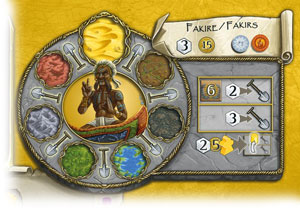
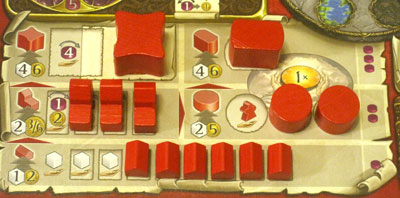
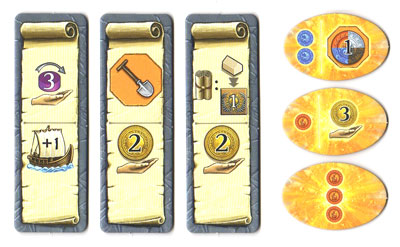
Phase III: Cult Bonus and Clean Up
All players are awarded Cult bonuses, (if applicable) depicted on the right side of the current Scoring tile. Then Cleanup begins. All Action tokens are returned or removed from the Action spaces if they were used. One Coin is placed on all the “unchosen” Bonus cards. And the current Scoring tile is turned face down to indicate the next round is about to begin.
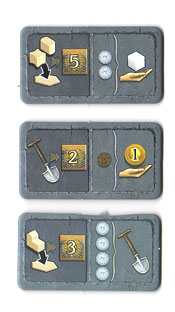
End of the Game and Scoring
Players first determine their Cult Scoring. You score 8 points if you are the player highest on any track, 4 points if you are second highest, and 2 points for being the third highest. Any lower and you’re out of luck. Ties divide the points between the players.
Next you determine your Area scoring. Simply count the number of structures that are adjacent or indirectly adjacent to each other. The player with the highest number of connected structures is awarded 18 Victory points. Second highest receive 12 Victory points and third highest receives 6 Victory Points. Again any ties and these points are divided between the tying players. Total all points and determine the ruler of Terra Mystica.
Components
The art and graphic work by Dennis Lohausen provide a strong thematic presence on the faction boards and the rule book, but are soon lost to the more dominant iconography and machinations of the game engine. The game board, Faction board, and all the assorted tokens are vibrant and iconography is crystal clear. The sheer volume of components makes the game impressive and each has high quality detail. It is a beautiful game when laid out and the graphic design is very intuitive. Storage bags are also provided for every single piece. One slight disappointment: without an insert, the pre-bagged wooden Faction components dinged up the game board a bit as they shifted around during shipping.
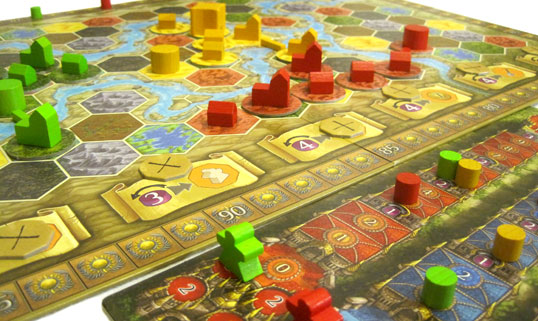
Learning Curve
High. The game play is fairly straightforward but as your resources grow so do your game play options. The iconography does take a few rounds to get used to. Mainly, although the game comes with 5 Action overview tiles, but no written turn reference chart – and the game could really use one. Many small rules exceptions are hidden in paragraphs in major headings in the rulebook. The rulebook is well organized an illustrated, but lengthy.
Who would enjoy this game?
Final Thoughts
Upon lifting the lid from the Terra Mystica box, one can’t help but gasp at the quantity of the components and the spray of color that hits you. (and the “new game” smell of course). Turning to the game set-up page, and viewing the graphic list of components gives you another chance to swallow hard. You may feel you’ll have to terraform your game table just to set this one up. But fear not! Roll up your sleeves, and dive in!
Terra Mystica offers a “first play” introductory game for two to five players which provides recommended factions, a predefined starting placement of structures as well as specific Bonus cards and Scoring tiles to make the game more accessible and balanced out of the gate. There is however no change in the game play after this initial set-up – which is a blessing since learning two versions of a game this size would be daunting. There is also a complete step-by-step walkthrough for setting up faction boards and the game board that is very clear especially considering number of moving parts. Once explained, set-up is a breeze on subsequent plays of the game. Leaving the introductory game behind, players are free to choose their Factions and there is an added procedure for placing first structures. Bonus tiles and scoring tiles are randomly chosen as well.
Placing first structures and choice of faction will shape your game experience, and the fact that most factions come with a special ability, and a unique Special action ability that is revealed when a Stronghold is built, provides a unique strategic option and also great interactivity between players and factions. Most of these Abilities and Actions are rule breakers (pay only 2 Workers for a Spade, skipping a river space when founding a town and so forth). The Stronghold Actions are quite powerful: (Taking double turns and transforming an adjacent space to your terrain type every turn). With every game, players can explore each faction’s traits and how they interact within the game matrix.
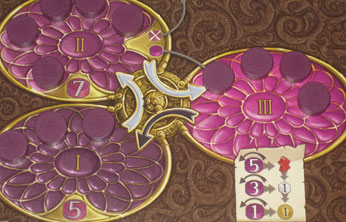
There are a few standout mechanics: first the use of Power as a resource. In a unique mechanic, Power is not taken and lost from the Faction board. Instead a system called “The Bowls of Power” is used to establish a cyclical resource engine. If Power is gained, it is moved from one “Bowl” to another. First from bowl I, then bowl II. If no power tokens are in bowls I and II, power cannot be gained until spent. To spend power, tokens are moved from bowl III to bowl I. If no Power token are in bowl III, Power cannot be spent. The initial distribution of the Power varies between factions, with Mermaid, Swarmlings, Halflings, Engineers having a slight advantage starting with 3 tokens in bowl I rather than 5 for the rest of the factions. The Fakirs are most handicapped in their use of Power starting with 7 Power in Bowl I. Power action are potent and even necessary, the only way (aside from one Faction’s ability) to build a bridge is a Power action. So its not like you won’t be needing it. Oh and it can also be spent to gain the other three valuable resources in the game. Losing, gaining and spending Power can shape a lot of game play strategies.
Terraforming (changing the terrain to match your faction) is the only way to build, which is the only way to expand and the main way to earn final Victory points. And you need resources (Spades) to do it! When upgrading structures, (which give you more resources and unlock actions and earn Favor tiles) you must remove the current structure and replace it with the upgraded version. (Dwelling > Trading house and so forth). Thing is, all your structure tokens are stored on your faction board. Underneath each structure token is an image of the resource you gain when that structure is on the Main board. When you return that structure to your faction board, it covers the image of the resource gained, which will then be unavailable to you during your next Income phase. So, upgrading to improve you area of control and points, come with the sacrifice of upcoming resources. This is a wonderful balancing mechanism.
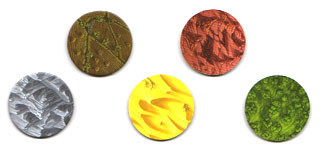
Another balancing mechanism tied to placing new structures is when building in a hex adjacent to an opponent’s structure, your opponent may spend Victory points to gain Power equal to the value of the structure. (Remember how cool Power is?).
In the end, it’s all about managing resources and gaining an advantage in Victory points by area control and advancing on the Cult tracks for bonus points. However, the game is so chock full of subtler scoring mechanics that it will blow your mind.
Is Terra Mystica better than other Eurogames out there? Maybe. It certainly is in a class by itself. But let’s face it; all those fiddly little bits and tiny wooden pieces shifting around the game boards like a crazy glockenspiel is simply irresistible! And even though a thoughtful, calculating gamer may be able to devise a strategy using the pure mathematics of the game, there is still a chance for a player with less grey matter between their ears to compete. It’s a balanced, engaging game that moves quickly and has a lot of charm. Pack a suitcase, bring an extra blanket, and stay for the night in Terra Mystica!
User Reviews (10)
Add a Review for "Terra Mystica"
You must be logged in to add a review.


 Terra Mystica
Terra Mystica
Terra Mystica is a strategy board game created by Jens Drögemüller,
Helge Ostertag and Uwe Rosenberg. It’s a very solid game, but it might look overwhelming at first.
The goal of this game is to develop your faction/race the best you can by building different structures and buildings. The problem is, you can’t build on just any type of terrain. The race you’ve picked wants a specific type of terrain, and by using your faction’s powers, you can “terramorph” the ground into what your race prefers.
(for example: the Dwarves like mountains and can only build
on mountain tiles; so they can use their powers to terramorph Plains into Mountains)
There are 14 different races, 2 for each type of terrain available.
Some of those races are well known, for example: Dwarves, Giants,
Mermaids,…
But this game also includes many new races:
Fakirs, Nomads, Auren (Spirits of the forest), Cultists,…
Every faction has it’s own pros and cons and knowing them all
makes the difference between a good and an excellent player.
After reading the rule book (which will not only learn you the rules but also introduces you to the Lore of the different factions), you will notice that Terra Mystica isn’t so hard as it looks. The gameboard
and faction boards are well designed and every information you need is
illustrated on them. Of course you need to know what some icons mean, but after playing ones, you will definitely understand them.
The most fun thing about the game is that you can win in many different
ways:
You can choose to build your cities adjacent to another player’s
territory, which gives your opponent some benefits but the cost of your
Trading Houses is reduced
or you can build your structures far away from
anyone ,which gives you more control of the adjacent terrains.
You can focus on Spiritual evolution or quickly rush
your Stronghold so you have its bonus.
…
This game isn’t well known and I believe that’s a
shame. I played it many times and it’s really fun to master all the
different races and strategies. The chances of getting bored is close
to 0 so…don’t hesitate to buy it if you like the theme!
Pros
– many factions
– different possibilities to win
– nice Lore (back story factions)
– Terramorphing is a cool concept
Cons
– might be overwhelming at first
– factions not always equally balanced in my opinion
Conclusion
I would recommend this game for avid, strategy, casual and power players.
It’s a little hard to learn for kids and it takes some time explaining
how it all works so it’s not really a game for social players.
But the people who like to think before they act will enjoy this game
a lot.
The only thing left to say is:
Have a nice day!
Terra Mystica is an empire-building/area control game with a fantasy theme for 2-5 players. The game puts you in charge of a race attempting to expand influence across a continent by building towns and other structures. The “hook” in this game, is that first, you must terraform the surrounding area to your home terrain type before you can build on it, by spending workers to change the very ground.
The game is divided into 6 turns. On each turn, players take actions, one at a time. Each player may take as many actions as he can, or desires per turn, however, the actions are taken in turn order around the table. This keeps the game moving, as it is never very long before you get another action to take, and you can spend a little time while others are taking actions to plan your next action out. Planning your actions out is pretty important however, because with each player doing actions between your actions, it’s possible that some actions you want to perform are taken by other players before you can get to them.
Each player has a race, portrayed by a player board in front of them. When starting the game, you place all the pieces of your color on your board in the indicated spaces. Each piece covers up an income icon of some type. The different types of pieces can each be upgraded to other pieces as indicated on the board. For example, the simplest piece, the settlement, provides one worker per turn when on the map. It can be upgraded to a trading house, which provides power and gold, but when you do so, the settlement returns to your player board, and you lose the worker income. This creates an interesting “economy management” mechanic, where, you need to be careful not to over-upgrade your placements, as you can destroy your lower economies (workers, or gold, etc)
Each round of the game has a special bonus, such as gaining victory points for placing specific structures, or performing certain actions. In addition, at the end of your turn, you pick a personal bonus, that applies only to you in the next round.
One of the best mechanics however, is the power bowls. On your board there is a set of three bowls with chits in each one. If you gain “power” as an income, or via other means, you can move the chits from one bowl to another. When you have chits in the final bowl, you can spend them on special actions, or buying additional workers, etc. Yet another economy piece to keep in mind when playing!
Overall, the races are pretty well balanced. There are a few that are a bit more difficult to play effectively than others, as well as a few that initially seem over-powered, but as you play the game, you will come to realize there are a bunch of different ways to play and win this game, and each race takes time to master. This gives the game a ton of replayability in my opinion.
The game plays very well with just about any group size. They claim about 45 minutes per player. This is pretty accurate for your first game or so, but once you become accustomed to the game, you will find it plays a bit faster than that. With two players, you can play an entire game in about an hour. As a two player game, it works very well, however, you may enjoy the game a bit more if you intentionally start the game with at least one of your towns near the other player. Players of Settlers of Catan will initially want to place towns far apart, to avoid crowding, but this game actually rewards crowding, so you can miss out on that mechanic if you place towns on opposite sides of the board.
Pros:
A little confusing at first, but the rules are extremely well written, and a handy chart on the back of the rulebook explains the racial powers quite well. It’s easier to learn than it looks.
It weighs a ton. It is chock full of wooden and cardboard bits that are of extremely high quality.
Great replayability via 14 different races.
Many paths to victory.
Almost no luck involved, purely a strategic experience.
Cons:
A single player with analysis paralysis might slow the game down.
The game looks very complex, and might frighten players off.
Sometimes the game feels a little short, and you wish it went on for another round or two.
Overall, this is one of my favorite games. It is wonderful to play. It could almost be described as a “less-stabby” version of Settlers of Catan, and I think people who enjoy that game would fall in love with this one instantly. I find myself wanting to play it over and over to try out different races, and strategies, and ideas of how to do things. That by itself is what makes it a great game.
Terra Mystica falls squarely into the 2 hour strategy game category that seems to be taking a back seat to shorter games, but don’t write it off just yet. This game is everything a strategy gamer could want and more.
A game of Terra Mystica takes places over 6 rounds. Each round players use their power, money and workers to build a thriving civilization. Players will choose a faction from 1 of the 7 starting terrains. They will place their starting dwellings onto the board on 1 or 2 of the hexes of the corresponding color.
In order to move into a terrain that is not of the same color, players must terraform those tiles and it’s this terraforming that causes your first major hurdle. Terraforming can be very expensive and finding ways to do so without using the shovel track will be key to success.
That’s where power comes in handy. When players build next to other players they will get to advance their power. As your power grows you can use it for things like terraforming, gaining workers, coins, or priests to send off to a cult track for end game scoring and the opportunity to gain more power. If you’re short on power you can sacrifice some of it from the game completely to use some now. This can get your economy going in the beginning of the game.
Another interesting thing about Terra Mystica is that as you upgrade your buildings, the buildings you are replacing go back to your player board, lowering your income of power, workers, or coins. Learning to manage this situation is key to success in Terra Mystica.
Though there is direct attacking in Terra Mystica, player interaction is a big part of the game. That power that I spoke of is extremely important and building next to your opponents is the main way to get that power. This leads to a certain tension as you are always worried whether your opponent is going to cut you off or take that next space you need to form a town.
This has led to the criticism that Terra Mystica should really only be played with 4 or 5 players. I would disagree, because I’ve had a great deal of fun playing it as a 2-3 player game, but the experience is much different.
Terra Mystica is a game that you could spend an entire lifetime mastering. It is my favorite game and I know that, as long as I have a board game collection, it will remain upon my shelf.
Terra Mystica is a euro style game combining resource management and strategic building placement with some fantasy theme elements. The components are well made and durable. Game boards are beautiful and functional, everything double sided with art. Personal game boards are race specific, with bonuses and abilities – each elegant as it tracks your tech tree, resources and economy. All boards, tokens and chits are consistent and clear with their symbols and mechanics – and they have to be, as there is a lot going on in this game. While the game comes down to Victory Points in the end, game play is focused on strategy with several available paths to gain points along the way. Players do not buy or trade resources or aggressively interact (no combat), but build with what they have, each building or upgrade changing each player’s economy. The real interaction is on the main board, where proximity to your opponents helps drive your economy but creates conflict for expansion, and terraforming changes the available landscape.
But before I say it’s perfect, let me point out a few cons:
1) It’s not easy to learn or teach to non gamers. New players can be overwhelmed by the amount of game here, and the first game is almost always a throw away full of regret of “what you should of done.”
2) It’s often not as fast as it should be. While the game can easily be played with experienced, focused players in 60 or 90 minutes, with new players it will take 3 times longer, and Analysis Paralysis can drag out a game easy.
3) End of game burn out. Whether it’s new players, or an intense game, you can at the end feel like the game beat you, even if you win. But this is part of the addiction of the game, the need to play again just to do it differently. You can often feel that you can do better.
4) 2 Player games aren’t as good as 3-4. 5 are more challenging and longer. If playing 2 player check out online variants and restrictions to enhance play.
With that said, my group and I love this game. Once you get how much game there is and get a feel for how the rounds progress its easy to get involved. 3-4 experienced players who don’t suffer from Analysis Paralysis can cruise through a game and will often play a second in a row. While it may not be light hearted fun, we all really enjoy the challenge. 14 different races, and terraforming combined with all the different strategies for Victory Points open up a lot of replay value.
I expect this will become a classic along with simpler games like Settlers of Catan and Power Grid, and more involved works like Agricola and Twilight Imperium and some how sits nicely right in the middle of both groups.
OK, I realise that not everyone has the same taste, and my 10 out of 10 may be someone else’s 9.99, but here’s my view . . .
The strongest point in Terra Mystica’ s favour is its level of complexity. I like complex games with interacting aspects of the game being used by the other players. TM, as you can read above, has no dice and so all the results are down to player skill, or perhaps more honestly, their correct assessment of what their opponents may do. But please don’t get me wrong! While I like complexity, I don’t like huge rule books with tiny modifiers applied to virtually every action (I heard there’s a WW I I war game where the Italian units get a dice modifier because they had pasta the night before, or something like that). TM is detailed but largely intuitive. The rules give a wide scope of actions, but the options are clearly shown on your own card and game board.
So often I have played games that would be better if they were just a little deeper, and from time to time, I give in with a game or lose interest because it’s not so much a game as an alternative life! TM, for me, is that very rare class of game where the complexity level is just right and necessitates planning, strategy adaptation etc etc but you don’t get a migraine.
I play with friends on a competitive level, but the play is the game and winning isn’t the only goal. Therefore, with TM, there are times where we point out ‘Don’t forget this round you also get victory points for that sanctuary you just built!’ Perhaps in National Championships you should only get the points you remember yourself, but good sportsmanship doesn’t spoil the game, and actually helps everyone get used to the rules.
Right, enough about complexity. Next strong point . . . Replayability. With all of the 14 different classes, their individual bonus strengths and the combinations of their interactions, plus different initial placements, the variety of results is incalculable. This game could be played every week for a long long time and you would still be trying different tactics to improve your game.
I genuinely tried to think of negatives about TM, as I don’t vote a 10 if I can find a fault. I did consider that perhaps the playing pieces (in a perfect world) could have been miniatures instead of wooden cubes etc, but actually, in spite of all the flavour of witches, giants and fantasy, this would not improve the game. TM, at its very heart, is an abstract game which, I would argue, has more in common with chess than Dungeons and Dragons. Well, maybe.
Anyway, I hope this review is not spoiled by my over enthusiasm. My daughter is less keen on the game than I am, and says she just doesn’t quite see why there is just so many aspects to the game ‘Why religious cults, why rivers, why such convoluted power system?’ All the little elements of imagination and originality that I love!
Some few games are destined for immortality. Monopoly, Risk, (long pause of many years) Settlers of Catan, and, I think, Terra Mystica. If you haven’t tried it yet I couldn’t recommend it more.
This game is awesome! 10/10 to me.
Pros:
* Game board is designed so you could easily understand what does what, how many resources buildings and improvements cost, how many points you get for each action, which are special abilities to each race, so you do not need to reread again and again rule book.
* Race enriches game, so you get different game experience with each race.
* Game has eliminated the factor of luck, you do not have to roll a dice, shuffle or draw cards, etc, your actions does not depend on luck, everything that affects game is a result of your choices.
* It looks awesome;
* You can get points in various ways, by building up an empire, religion, getting points using special abilities from each race, founding cities, not always the person who has built up the biggest territory/empire wins.
*Each race has different building costs and given goods from same buildings and different special abilities.
Cons:
* Everything comes in a plastic bags and there is like a ton of pieces so it is really frustrating to set up game. For easier set up it is advisable to buy or make carton/wooden case with sections, which totally eliminates this problem.
* Game is complicated, with many rules, takes really long time to explain game to others.
* Not that much fun for two players.
Final thoughts:
* It would be excellent if there were different looking buildings and priests among race.
* Definitely not suitable for beginners.
Terra Mystica thudded (and I mean that literally, have you lifted this box!) onto the scene late in 2012, it’s a box heaving with wooden components and at first glance once set up sprawled across a table is sufficient to send some gamer’s running to the hills screaming.
I first encountered Terra Mystica last year when I was introduced to the game at my local club, and it was with some hesitation that I sat down to tackle this beast, myself feeling a tad inadequate in its company. I was fortunate to have a good teacher (thank you Graham) who managed to sum up the rules and get us playing in relatively short time and without me developing a brain tumor or him punching me during the process.
And pretty soon I found out a couple of things about this game, despite its imposing table presence with its heaps of strange shaped wood and bundles of counters and chits, its actually a very intuitive and nuanced game and a great deal of fun to play. But I suppose you’d like something a little more detailed than that, OK then deep breath and here we go.
The games theme has you adopting the role of one of 14 different fantasy races each with their own unique traits and abilities, yep this is a Euro but with a fantasy theme. Its received some flack since release accused of the theme being pasted on, now granted it is more a thinly applied lacquer rather than the great big splosh you see on most Ameritrash games, but it still adds a pleasant aroma of pine to the proceedings (or maybe that’s all the wood) and thematically works alongside some of the more exotic mechanisms ticking away under the hood. So what are you actually doing in this, well the main goal (this being a Euro and all) is to amass the most points by the game end, you achieve this by building settlements over a very colorful hex covered board. Each of the hexes are a type of landmass from forests and deserts to mountains, and depending on your chosen race only one of these will make you feel suitably cozy enough to be able to put down roots. You do this by terraforming map tiles to the color you need and plonking your buildings on them. And that’s pretty much it, everyone is doing the same thing, obviously there are other more subtle goings on, with your opponents proximity giving you bonuses as well as he, and numerous careful choices of what modifiers to apply and at what times to utilize them.
Now I’m not going to run through the rules for this because I can’t without this review going on forever and in the process boring you to death, and me having a seizure, but what I will do is focus on some of the shiny bits that make this game so great.
First has to be the amazingly designed player boards, these are just the cleverest things and once you’ve got one set up and ready to go in front of you its like a selection box of gaming possibilities just urging you to dig in. Brilliant design happening here as they function both as player aide and resource tracker whilst sat in front of you like some TV dinner tray, goading you to pluck at the tasty morsels uncovering more and more cool stuff hidden beneath them. Its just such a well conceived idea I’m surprised I’ve not encountered it before, so yes the player boards brilliant.
The other cool mechanism is the mysterious bowls of power. In the top right of your board are representations of 3 mystic bowls that you have to cycle your magical purple power stuff to enable you to use cool bonus abilities. Its a sort of currency that you have to filter through this bizarre one player aide three cups thingy to be able to use, it sounds barmy and quite possibly is, but also becomes rather addictive. Your mystical bowls of purple power are often activated by an adjacent neighbor building something and you leach off them and jiggle your power about to produce a usable energy at the end of the process. But it is finite as once used it goes back into the first bowl and you need to filter it through the whole mysterious system to use it again. There is the option to BURN!! your power which accelerates the process and gets the polished purple power into your mits, but in so doing you burn up one power for each you bring through, its a tactic to be used sparingly, or you could find yourself coming up short when you most need it.
And that brings us back to the main game, because essentially this is what you are doing a great deal of the time through out your strange tree hugging journey that makes up a round of Terra Mystica. You build an engine to produce a resources that you need and then spending those changes your original engine, which means you then get different stuff and then try and get smart only to… where was I? Ah yes, every forward step has repercussions, everything you take off will mean another piece returning to your board covering up areas and limiting your income on the next round. It really makes much more sense when you are doing it.
Besides all of this crazy resource gathering and magic bowl rubbing, there are also bonuses that pay out for doing specific things during a turn like building a specific building or are dished out once everyone has finished doing their thing each round. These offer further options that you really need to be planning for from the start to guarantee you make the most of them. You also get the option of picking a start of turn perk each round that will offer either instant gratification or points bonuses. And these bonuses become more and more important as the game progresses, with the option to pass on your turn for a pick of whats available before the others. Which has resulted in a couple of games where everyone is waiting for everybody else to pass and return their chits, leading to a scrabble of meeples and harsh words as everyone snatches for the one they need.
And then there’s the cult track, which see’s you sending off your colonies priests to some jimmy jones style cult to worship, nature stuff. Do well on this and your little fanatics will reward you with more bowl rubbing powers and can amass a huge points payout at the end.
I’ve really only touched upon the surface here, and to be honest no written review is ever going to do this one justice its something you need to experience really to get whats going on. If I had to pigeon hole it I’d call this the experienced gamer’s Catan, its probably as close as I could get to an elevator pitch and even that really doesn’t do it justice.
Now its not all fun, fun, fun. Despite the games best attempts and the sleek and very well put together rules this one still has a pretty steep learning curve, anyone attempting this for the first time needs to have had some experience of modern board gaming and a good tutor. And for goodness sake if you are going to teach people make sure you’ve read the rules at least four times and played it through a couple more, because a shoddy set up on this one and nobody is going to thank you, which would be a shame because this is a game where its subtle tactics only really start to emerge on subsequent plays.
And on those following plays It all starts to become clear, well only its doesn’t. What is clear is Its very easy to make some poor decisions in the early turns that can see you struggling to recover from, you need to start your resource engine carefully to build toward that end game goal, and an early misstep will mean failure. And as each of the races have subtly different powers you can’t play them all the same way. After having a couple of successful games using the Witches I’d taken on the Giants and confident of my amazing world building skills subsequently managed to bankrupt my economy within two turns which resulted in me never really having a chance to catch up. And nobody wants an angry giant.
With more players it is easier to salvage your game but in 2 or 3 player games poor placement of your starting locations and burning valuable resources transforming stubborn terrain can really bog you down. When I started to write this review I found I kept recalling more and more rules and deeper strategies as I cast my mind back, you certainly get a lot of value in here and it will reward you coming back for more and with the mixture of races it will be a while before you’ve exhausted what this offers.
And regarding any AP heavy players out there, yes those prone to it will encounter brain seizing moments, and repeated plays can add to this, as its then you start try to plan ahead. So be warned as to who you play this with or bring a book, or a stick.
So who is this for? I have to say Euro players are going to get the most from this, despite the designers attempts to apply a story to proceedings that all takes a backseat to the mechanisms and is more a flavor than a selling point, but then that never hurt Lords of Waterdeep or its sales. If you are looking for a war game then think again, this is more passive aggressive with no actual direct conflict. I’m not the worlds biggest euro fan and often find the dry mathematics and math heavy play styles a turn off, but this is nicely balanced and it draws you in with its Witches and Gnomes and somewhere during the game does a subtle shift into the full Euro, it offers rewards for anyone coming back for more with a fiendish array of options. And it has mystical bowls and purple magic power stuff.
So I recommend this its a solid game and for me it fills that mid to heavy Euro gap in my collection and with its theme will guarantee it hitting the table with my group. I’d strongly suggest a try before you buy where possible because it is going to have that love it or hate it thing going on. Personally I love it.
Terra mystica is a complex awesome completely fantasy version of settlers of catan with so much more depth. You choose one of 14 different races, and with different special abilities, and try and gain points by building the biggest city’s or completing little bonus tasks for the round, or advancing yourself in a cult. Problem is you need recourses, so build buildings to get them, next problem is you need resources to terraform a space to the environment that your race can build on, so you need more reassures so upgrade your buildings, next problem is they replace your old ones so instead of getting a worker for that dwelling it’s now a trading house so your get magic and gold, but you still need workers!
It’s all about balance, and figuring out what your race is good at, how you can get the most points, coz having the biggest city is just one way to get them, huge amounts of strategy and prior playing need to be involved.
One possible flaw with this game is lack of player interaction, you can pre-empt where they are thinking of building next and try and block them but that’s about it, there’s no other ways to directly effect another player, you just have to observe and adapt to claim more points that round.
The game is split into six rounds each with two bonus objectives to get more rewards during or at the end of the round, the six rounds will probably last about 45mins when everyone knows what they are doing, which sometimes feels a little short to me but once I get used to how most the races play I’m sure I’ll be able to accomplish more in that time. Is a great game and after the initial ‘Wow! There’s a lot of stuff going on here!’ Sensation play flows quite well and the phases of play make logical sense making the rules easy to memorise.
I have to admit I didn’t know this game before I got it as a present, so I was surprised to read the positive comments about it and see the high rates. In fact it is a great game with random factors reduced, for me similar to the Puerto Rico.
Although the rules are quite complicated at the first glance reading the instruction carefully is worth it’s effort. In fact the game is not as complicated as it seems but winning it is not so easy: you have to take advantage of your faction’s special ability and develop a strategy basing on it. There are many ways to win but you have to chose the best taking your faction and your opponent’s moves. Quite the same as in Puerto Rico or Caylus there are many ways to get winning points and you chose which way is the best for you.
In my opinion it’s best for four players; we’ve tried to play in two but it wasn’t such fan as it was when there were more of us. There is no “direct” interaction in this game, but your opponents may perform the same actions you wanted to perform before you (for example cast a spell) so you have to predict their moves as well.
The only problem with this game is that the factions are not well balanced. Some of them are too powerful while the others abilities, although interesting, require more resources and turns to work.
Conclusion: taking the number of factions and possible strategies every Terra Mystica is different and requires different thinking. I would recommend it to the players who like strategy games.
Played it two times on different occasions. I did not feel the desire to play it (ever) again. It is just so convoluted and its micro management amounts to not much in the end.
initial appeal:
The components and the board look ugly. the purple circles remind me of brains or internal organs and i don’t want to touch them.
Gameplay:
Each player takes so long, and picking a special ability, meeting the requirements, everything feels like .. work. And in the end you build a temple, and some cities, that look like wooden chips, and the game ends.
Long term inters: for something that takes 2+ hours with nothing much happening most of the time, no thanks!